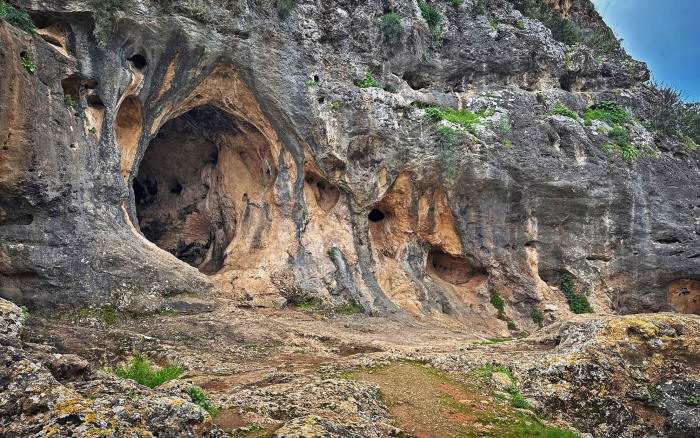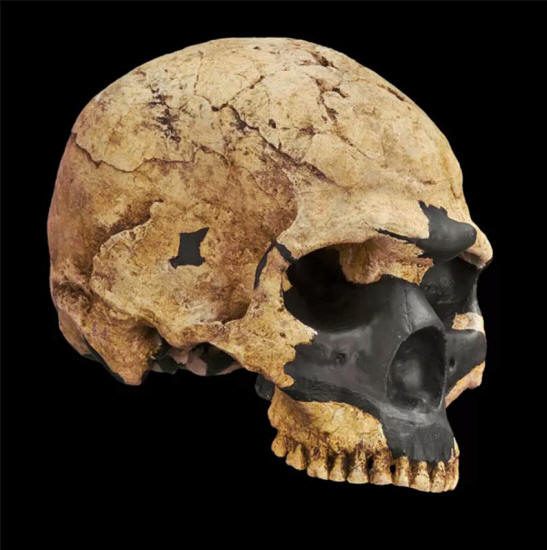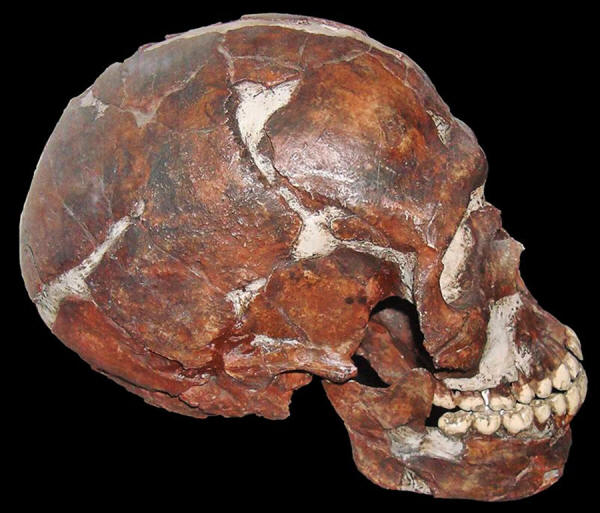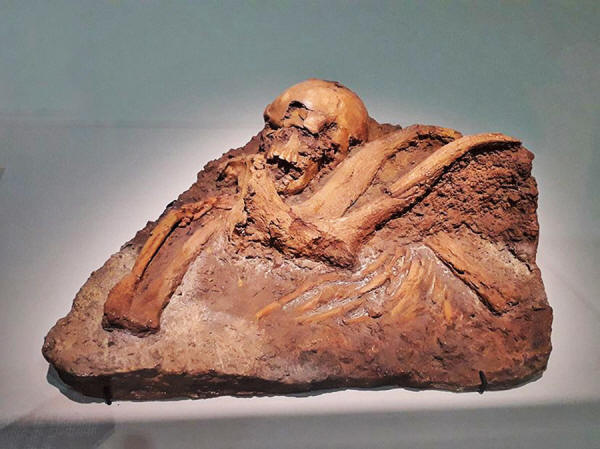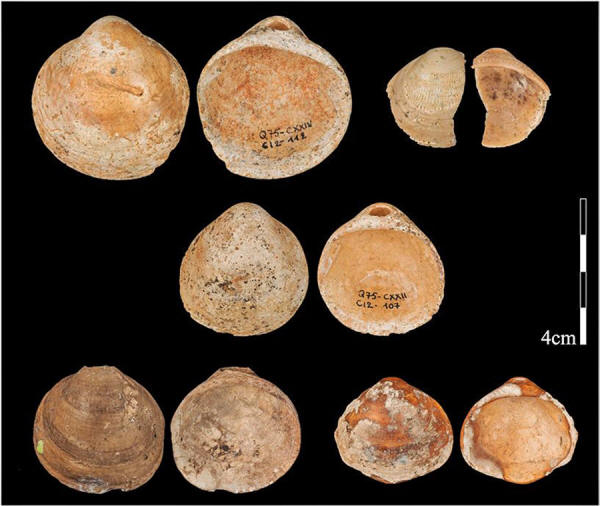|
by Nick Longrich
at the University of Bath, UK. Mount Carmel, Israel.
Photo supplied
by the author of a diverse human family tree.
Aside from Neanderthals, who were the 'other' Homo Sapiens, and why did we replace them?
About 140,000 years ago, during the Ice Age, nomadic hunter-gatherers made camp here. The sea to the west had receded, exposing a broad plain covered with groves of live oak, almond and olive, meadows filled with asphodel and anemone.
Herds of fallow deer, rhinoceros and aurochs roamed the plains.
People hunted animals with stone-tipped spears, and foraged wild mustard and olives. And when they died, they buried their dead by the mouth of the cave. The skeletons found here represent some of the earliest known members of our species, Homo sapiens.
But these Homo sapiens were very different from us.
showing
bone structure with dark and light patches. recovered from Skhul cave. Courtesy the Smithsonian Institution
But, despite their primitive appearance, they
weren't our ancestors; they appear too late in time. They're a side
branch of our evolutionary tree, one that went extinct, leaving no
descendants. Why did we survive, while they didn't?
They lacked the peculiar anatomical traits that modern humans share - small brow ridges, bubble-shaped skulls, reduced jaws, thin cranial bones - which are typical of juveniles of other hominins and apes. Compared with other hominins, we're literally baby-faced.
Selection for juvenile traits - low aggression,
openness to novelty and new people - likely made us more social, and
produced our immature-looking skulls as a side-effect. Ironically,
it may have been this sociability and low aggression that made
modern humans so incredibly dangerous to these primitive Homo
sapiens.
Soon after, the remains of at least 28 people, dating to 90,000 years ago, were discovered near Nazareth at nearby Qafzeh Cave. When they were first found, the Skhul and Qafzeh remains were among the oldest known Homo sapiens.
Today, a century later, they still are, and their
meaning is still debated.
A fossilised human skull in a side profile on a black background
showing visible
fractures and wear.
But in other ways, the Skhul and Qafzeh fossils
are strikingly primitive.
We don't know exactly what they would have looked
like, but they probably didn't look like anyone you'd see walking
down the street today. At Qafzeh, they punched holes in seashells, to string them on cords for necklaces
Their tools were part of a tool tradition known as the Mousterian.
Mousterian tech was advanced compared with the primitive Acheulian tools like hand-axes used by early Neanderthals, but more primitive than the tools made by modern Homo sapiens.
The Skhul and Qafzeh people had abandoned Acheulian hand-axes for smaller stone tools, striking flakes and blades of disc-shaped stone cores.
They made big, triangular spearpoints called Mousterian points.
To do this, they used a flintknapping style called the Levallois technique, where a stone core was prepared and a large blade was struck off in a single motion. Levallois points were attached to throwing spears to hunt big game - and probably other people.
Curiously, Mousterian tools are also associated with the last Neanderthals.
The artifacts and behaviors of the Skhul and Qafzeh people were in some ways surprisingly advanced, surprisingly human.
At Qafzeh, they punched holes in seashells, to string them on cords for necklaces. Then, the sea would have been about 30 miles away. It's possible their wanderings took them that far, but it's also possible they traded for shells - a behavior not known in Neanderthals.
Ochre pigment, typically used for painting,
makeup and decoration, was also found covering some skeletons.]
A partially excavated ancient skeleton
embedded in a block
of soil displayed in a museum setting. discovered at Qafzeh cave. Courtesy the Israel Museum, Jerusalem/Wikipedia
The meaning of this practice is unclear - maybe these artifacts were trophies, charms or offerings.
Maybe they provided protection or help to the spirits of the dead.
And then the burials themselves hint at the idea of an afterlife, and the mere fact that so many bodies are found in a small area suggests they attached some spiritual significance to these sites.
Maybe loved ones brought the dead to the caves to
join the ghosts of their ancestors.
For a time, the skeletons were given their own species; later, they were interpreted as transitional between Neanderthals and modern humans, or even as Neanderthal-human hybrids. The current thought is that they are part of Homo sapiens, more closely related to us than to Neanderthals.
But if so, how do they relate to us?
If you're interested in the origins of modern humans, you might want to emphasize the modern aspects of their skeleton, but I find the primitive features more interesting.
This acknowledges both their link to modern
people, and the gap between them and living humans. Alternatively,
we might just call them the Other Sapiens.
We've now found archaic sapiens in Florisbad, in South Africa. They've been found in East Africa, along the edge of Lake Eyasi in Tanzania, and in the Herto and Omo Kibish localities in Ethiopia.
Archaic sapiens have been found in
Jebel Irhoud and Dar Es Soltan in
Morocco, and at
Iwo Ileru Cave in Nigeria.
Archaic sapiens were the most widespread, abundant and
successful humans of their
time...
An archaic sapiens skull was found at
Apidima Cave in Greece, and teeth
have been found in the cave of
Grotte Mandrin, in France. They're
apparently part of an initial sapiens migration out of Africa,
taking place tens of thousands of years before modern sapiens left
that continent.
Since archaic sapiens inhabited most of Africa where they had access to plenty of game and plants to forage, they would have outnumbered Neanderthals, who were restricted to the more hostile environments of Ice Age Europe and Asia.
Modern sapiens, meanwhile, are thought to have
existed in a small area of southern Africa, with a total population
of no more than 30,000 people.
A jaw from Misliya in Israel dates to 177,000 years ago, and the skull from Apidema in Greece dates to 200,000 years ago, making these the oldest sapiens outside of Africa. They were around for a long time.
But they also survived until relatively recently.
Until about 50,000 years ago, they were the dominant Homo sapiens.
Before then, it's difficult to find so much as a tooth or a jaw that
doesn't have archaic features like theirs.
It's tempting to see archaic sapiens as our direct ancestors, because it would solve a big question where we come from.
In this scenario, the odd mix of primitive and modern traits seen in Skhul people and other archaic sapiens is because they're transitional forms 'missing links' between more primitive, Neanderthal-like hominins and fully modern humans.
It's a simple, obvious explanation, but as often happens, the simple, obvious explanation seems to be wrong...
Archaic sapiens just appear too late in
the fossil record to be ancestral to us.
have yet to be discovered...
The hominin fossil record is frustratingly incomplete. The oldest fossils of fully modern humans appear in the form of a few teeth from Mumba Rock Shelter, on the edge of Lake Eyasi in Tanzania.
They date to around 100,000 years ago, and lack
archaic features they're indistinguishable from people living in
Africa today.
These molecular clock techniques rely on the
principle that mutations accumulate over time. The longer two
populations have been separated, the more their DNA differs.
It's not an exact science it's almost a dark art but molecular clocks offer one big advantage over fossils:
And in human evolution, most of the record is
missing.
Given that the descendants of these people the San, Pygmies, Hadzabe, Bantu, and the diaspora giving rise to Eurasian and Amerindian peoples have small brow ridges, delicate jaws and thin skulls, they probably did too.
It's likely they resembled modern African
hunter-gatherers short, wiry people, with copper or brown skin, and
black, curly hair.
just keep on being archaic to the end.
Then they disappear, and we
appear...
If so, archaic sapiens can't be our ancestors the dates don't work. Skhul and Qafzeh people date to around 80,000-120,000 years ago. The Herto remains date to around 160,000 years ago, and the Omo Kibish 1 skull to around 230,000 years ago.
Remains from Grotte Mandrin in France date to about 54,000 years ago, and stone tools suggest that the last archaics in North Africa disappeared around 20,000 years ago.
Fiinally, archaic sapiens in Iwo Ileru in Nigeria survived until around 12,000-16,000 years ago, just before the end of the last Ice Age.
The archaics survived until very recently long
after modern humans had colonized Australia, after we spread out
into Europe and Asia, and after we crossed the Bering Land Bridge
into Alaska.
But if they were truly ancestral, they should be
either significantly older than modern sapiens, or far more modern
in their anatomy. So the timing suggests that archaics aren't our
ancestors. Instead, they're our cousins.
But they don't. Archaics just keep on being archaic to the end.
Then they disappear, and we appear. This
discontinuity suggests replacement, not evolution. Likewise, the
transition in stone tools is abrupt, not gradual as we'd expect if
they slowly evolved into modern humans.
These archaic side-branches must have split off
the sapiens main line sometime after sapiens split from
Neanderthals, around 750,000 years ago, but before modern humans
evolved, around 300,000 years ago.
Within modern humans, we see distinct groups in different regions the San in southern Africa have been evolving more or less in isolation for 300,000 years, and the Pygmies in Central Africa split off from the remaining humans around 200,000 years ago, and so on.
In the same way, early Homo sapiens probably saw lineages split off and migrate into different parts of Africa, the Middle East and Europe over hundreds of thousands of years.
Some lineages were probably closer to modern humans than others. The Jebel Irhoud sapiens, from Morocco, look even more primitive than the others theirs is an elongate braincase, almost like a Neanderthal. This is an archaic archaic human.
The Skhul and Qafzeh hominins are among the most modern in their anatomy, and may have been closer to us.
What we call the 'main line' and what's a 'side-branch' is clear only looking back.
We can call ourselves the main line because we're here, and they're not. Winners write the history books, and the anthropology textbooks. But, at the time, we weren't obviously the main line, and they weren't obviously side-branches.
Modern Homo sapiens was one, not particularly successful, side-branch, with a total population of perhaps 30,000 individuals among many competing sapiens lineages.
If an alien exobiologist had come to Earth to study Homo sapiens,
We know their brains were big, within the range of variation seen in modern humans, although a bit below average.
They were also anatomically similar to us, so it's reasonable to think they resembled us in terms of behavior. They likely had complex languages, complex tribal structures, and other features shared by all human cultures. They may have believed in gods, ghosts and magic.
These conclusions are speculative, but not entirely without evidence. That archaic sapiens buried the dead implies some sort of supernatural belief.
The Hadzabe hunter-gatherers of Tanzania place their dead in rock-shelters to join their ancestor-spirits; it's possible the people who lived at Skhul and Qafzeh buried their dead in caves for the same reason, and they too believed in ghosts and ancestors.
Moreover,
So it's reasonable to guess they had some form of
language.
never invented the sort of advanced technology
modern sapiens did...
A striking feature of the archaics is that they sourced materials over long distances, something we don't see in Neanderthals.
Qafzeh Cave would have lain around 30 miles from the sea, yet somehow these people got marine snails to make shell beads. There are two ways to acquire resources over such long distances.
One is to walk there through friendly territory.
Either scenario implies large, geographically
extensive social networks.
Various ancient shell artifacts on a black background
with a scale marker
indicating 4cm. Photo courtesy Oz Rittner/CC by 4.0
For 100,000 years, the Skhul and Qafzeh people seem to have used the same tools as the Neanderthals.
Another remarkable feature of the archaics is that they struggled to hold off the Neanderthals.
The archaics gained a foothold in the Middle East, eventually spreading as far as western Europe. Yet this incursion into Neanderthal territory ultimately failed.
That's very different from the pattern we see in
modern sapiens.
In no case were Neanderthals ever able to push back against modern sapiens and retake lost ground.
And whatever it was that gave us an evolutionary
edge over the Neanderthals, it must have given us an advantage over
archaic Homo sapiens.
Likely for the same reason that, ...and all other primitive human lineages vanished.
Modern humans spread and took their place.
We either killed them outright, or drove them
away and took their land. Left with less and less territory to hunt
and gather to feed themselves, they became fewer and fewer in
numbers. In time, they disappeared entirely.
This happened gradually.
Studies of human genetic diversity suggest that modern sapiens originally existed at low numbers perhaps 25,000 to 30,000 people. Assuming population densities like those of African hunter-gatherers, the entire population would have comfortably fit into an area the size of England or Iowa.
Meanwhile the rest of Africa Ethiopia, Tanzania,
South Africa, Kenya, North Africa, along with parts of the Middle
East and Europe was home to archaic sapiens. But, slowly, modern
humans spread out.
We first took a coastal route into Southeast Asia where we wiped out Homo erectus.
Then modern humans saw a rapid expansion around 50,000 years ago perhaps driven by the acquisition of the bow and arrow with modern humans rapidly replacing Neanderthals in Europe and the Middle East, and the Denisovans in East Asia.
Finally, we migrated into North Africa, displacing the archaic sapiens there around 24,000 years ago. The last known archaic sapiens disappeared in West Africa around 13,000 years ago.
The archaics survived remarkably late long after Neanderthals, after Denisovans. Even after modern humans reached Australia, Europe and the New World.
When we first appeared, there were perhaps 10 different hominin species, of which we are the only one to survive.
But even our own species was once far more diverse:
The extinction of archaic sapiens may not have been total.
It's possible that modern humans intermarried with these people, as we did with Neanderthals, Denisovans and perhaps Homo rhodesiensis humans seem to have a thing for cross-species mating.
If so, some archaic DNA might survive in modern human populations. At least some skulls do show hints of hybridisation.
A modern Homo sapiens skeleton from Nazlet Khater in Egypt dates to 33,000 years ago, making it among the oldest modern humans in North Africa.
While the remains are mostly modern, the jaws retain some primitive features; it's possible the Nazlet Khater skeleton is a hybrid. So archaic genes may have entered modern populations in North Africa, maybe elsewhere too.
Such interbreeding might be hard to recognize
interbreeding of sapiens with sapiens would be far less obvious than
interbreeding with Neanderthals, either in terms of skeletal
anatomy, or in terms of DNA.
always took ground against other hominins,
and we never gave it up...
That's long before modern humans left Africa, and about the time archaic sapiens moved into the Levant, suggesting archaic Homo sapiens was the source.
If so, then, statistically speaking, it's likely
that some of the genes modern humans acquired from Neanderthals
might originally come from archaic sapiens, in a sort of
genetic back-and-forth.
And any genes that persisted first in
Neanderthals, and later in ourselves, were likely kept due to
natural selection there's a good chance they're doing something
useful to our bodies, our physiology or our brains.
Everywhere modern humans went, we displaced archaic sapiens, never the reverse as with Neanderthals and Denisovans. They held us off for a time, sometimes for millennia, but other humans could never push back and retake the land they lost.
In civilized history, the rise and fall of
civilizations often came down to a few big battles, so luck must
play a large role in, say, the rise of Greek civilization versus
Persian.
Modern humans had an edge so what was it?
Modern humans invented weapons like bows, spear-throwers and stone-headed axes; archaic sapiens and Neanderthals neither invented them, nor did they even adopt these technologies from us.
Technological superiority wasn't just about weapons, either.
Modern Homo sapiens migrated into the high arctic of Siberia around 40,000 years ago, during the middle of the Ice Age something Neanderthals never did.
That's strong evidence that we mastered
innovations like cold-weather clothing, shoes, and the needles and
thread needed to sew them. Modern humans colonized Australia by boat
around 65,000 years ago; no other lineage crossed long distances
over water.
The hyoid bone that supports the soft tissues of the throat is highly modern in Neanderthals:
But it's possible we were more refined
linguistically, better able to communicate with one another to
socialize, and also to wage wars, compared with other humans.
African hunter-gatherers typically live in bands of several dozen people, which ally to form tribes of many hundreds or even 1,000 people.
Meanwhile, studies of Neanderthal DNA show low genetic diversity, suggesting more inbreeding they lived in smaller, more isolated social groups. Our big social groups must have given us more brains to solve problems and to devise techniques for making tools.
But maybe more important is the fact that,
If archaic Homo sapiens resembled
Neanderthals in having small social groups, this must have put them
at a disadvantage against modern humans.
Still,
A similar pattern is seen in domestic dogs dog skulls are shaped like those of wolf puppies, and they have thinner skull bones too.
The process of domesticating dogs for lower
aggression produced something that looks like a young wolf. This may
be a side-effect of selecting dogs for characters found in wolf
puppies less aggression, more playfulness, more friendliness.
If the bones look immature, maybe the brain inside was too.
Perhaps youthful creativity, imagination, faculty
for languages, playfulness, why's-the-sky-blue curiosity,
willingness to make new friends were all retained late in life in
us, compared with other humans with selection for child-like
behaviors creating our child-like faces.
was a long, grueling war of attrition,
not a blitzkrieg...
Low aggression could have helped us to form big social groups tribes of hundreds and thousands. And modern humans don't just form huge groups, we're unique among animals in being able to form peace treaties between different groups, and alliances between groups to defend or attack territory.
What made modern Homo sapiens so uniquely dangerous, might not have been a tendency towards violence and aggression, but friendliness, and the ability to forge alliances.
I alone am survived to tell thee.
Today, all human diversity derives from a small population that lived a few hundred thousand years ago. The picture was very different when we first evolved.
Then, there were 10 or more different human species.
Within Homo sapiens, we see this pattern repeated, with lineages others than our own stripped away, a diversity of peoples whittled down until only one remains.
We were just one of many different lineages, but now we're alone.
We don't know how this replacement played out.
In some cases, the large size of modern human social groups probably allowed our ancestors to move in and seize territory without a fight, forcing archaic humans onto more marginal land. But in many cases, the conflict between modern humans and archaic sapiens was likely violent.
The remarkably slow spread of modern humans it took perhaps 300,000 years for us to completely displace archaic sapiens in Africa implies that archaic humans resisted fiercely and effectively.
It took hundreds of thousands of years of intertribal warfare for modern humans to spread from our homeland in southern Africa to the far edges of the continent.
Even the final, rapid push from Egypt to the northwest tip of Africa took more than 10,000 years just half a mile per year.
The expansion of modern humans was a long,
grueling war of attrition, not a blitzkrieg. This also tells us
something about just how human they were the edge we had was
decisive, but not overwhelming they must have been very like us to
fight us off for so long.
In the same way,
To be more precise,
This process didn't begin with us.
Over millions of years, increasingly advanced hominin species appeared, with bigger brains and more advanced tools and language. They tended to displace the more primitive species.
The acquisition of spear-throwing and hunting by Homo erectus probably saw the primitive Australopithecus species killed off even hunted and eaten by their advanced rivals.
And in the Levant, we see a series of species move through, as new and more advanced hominins evolved in Africa and then,
This process did, however, end with us.
After thousands and millions of years, one lineage emerged to replace all the others. This probably explains something about our history, and our tendency towards war and conflict...
We may live in "civilization" today, but the genes within us are those that made us the sole survivors of hundreds of thousands of years of intertribal conflicts and bloody, genocidal wars.
We replaced all the other humans because we were
more "dangerous" than all the others...
|


